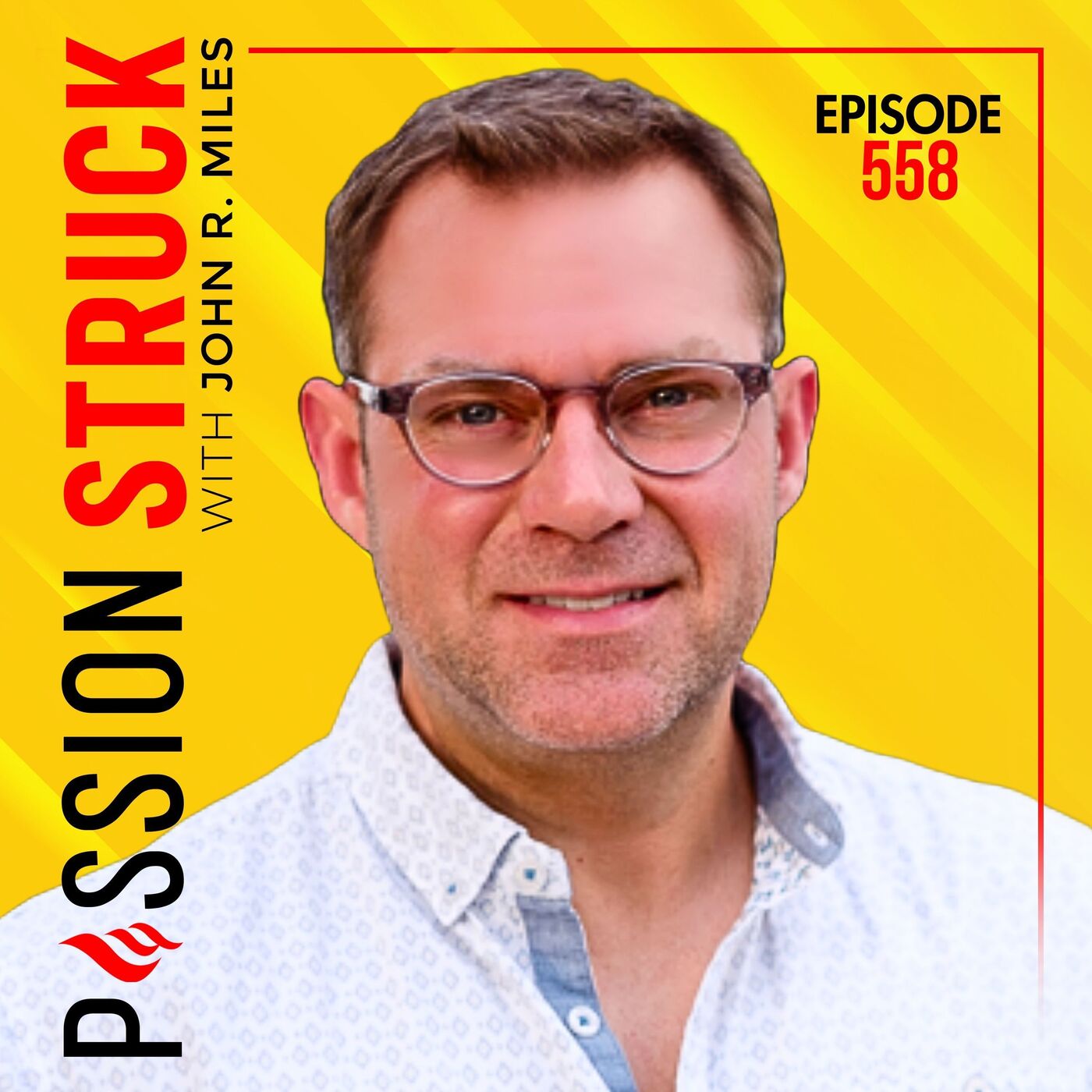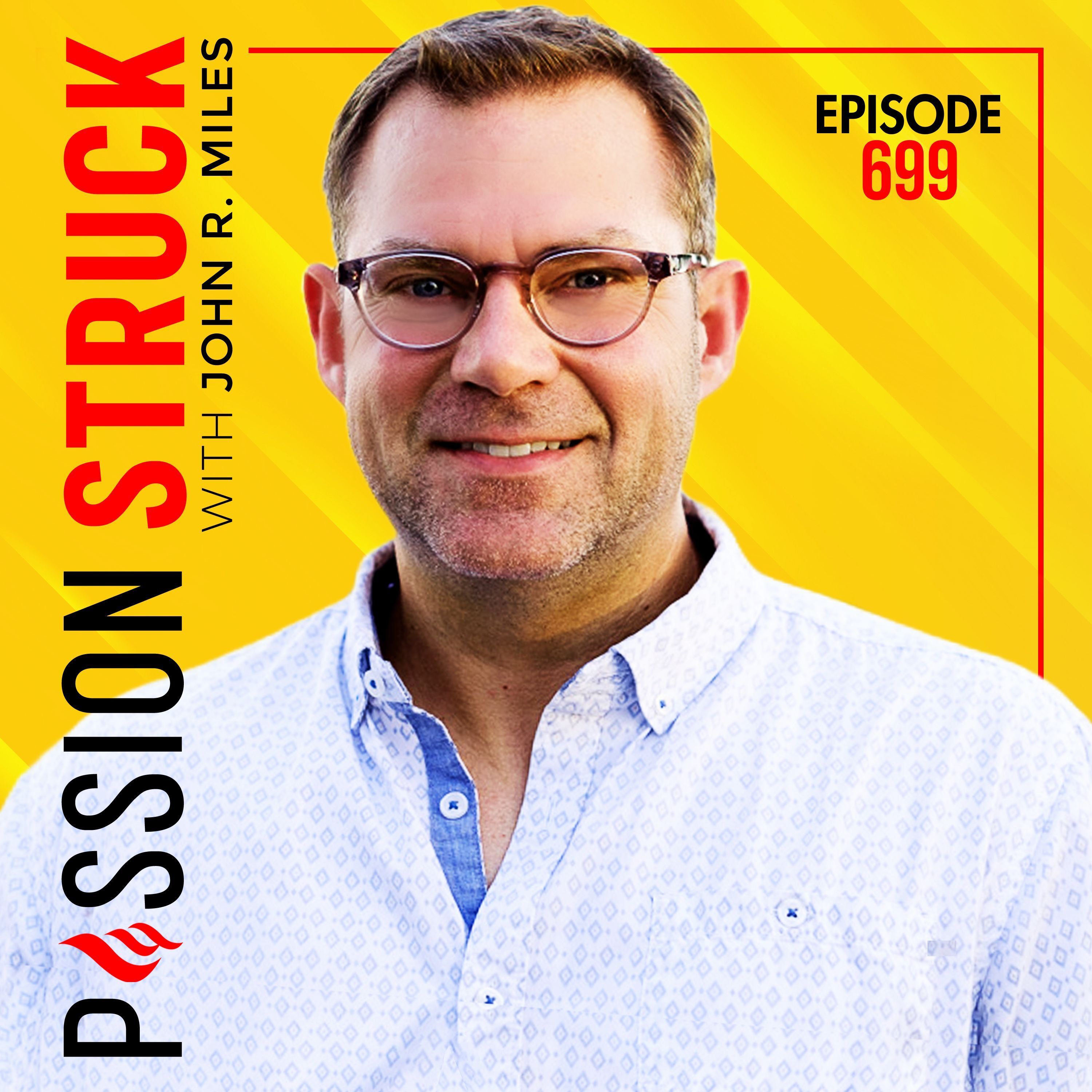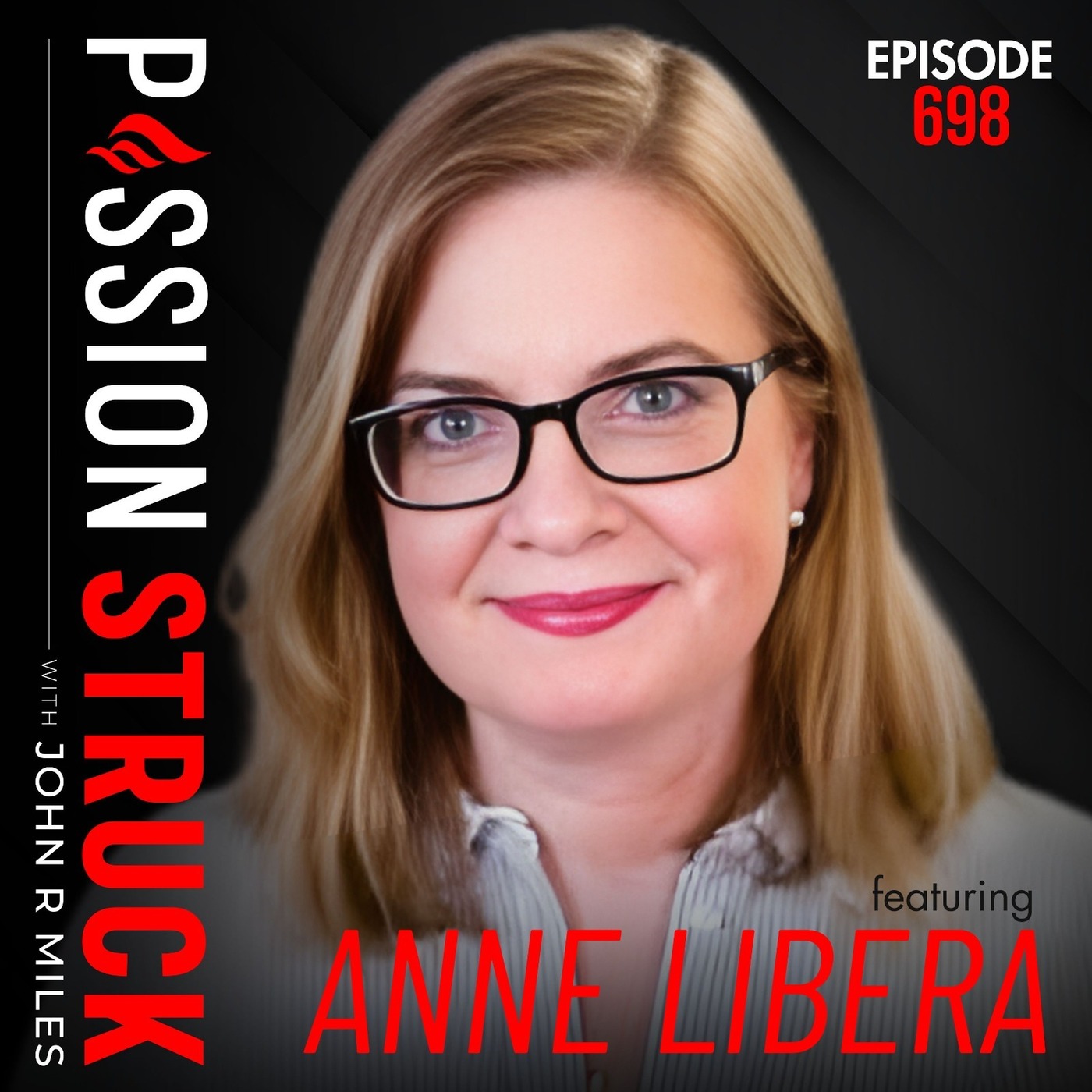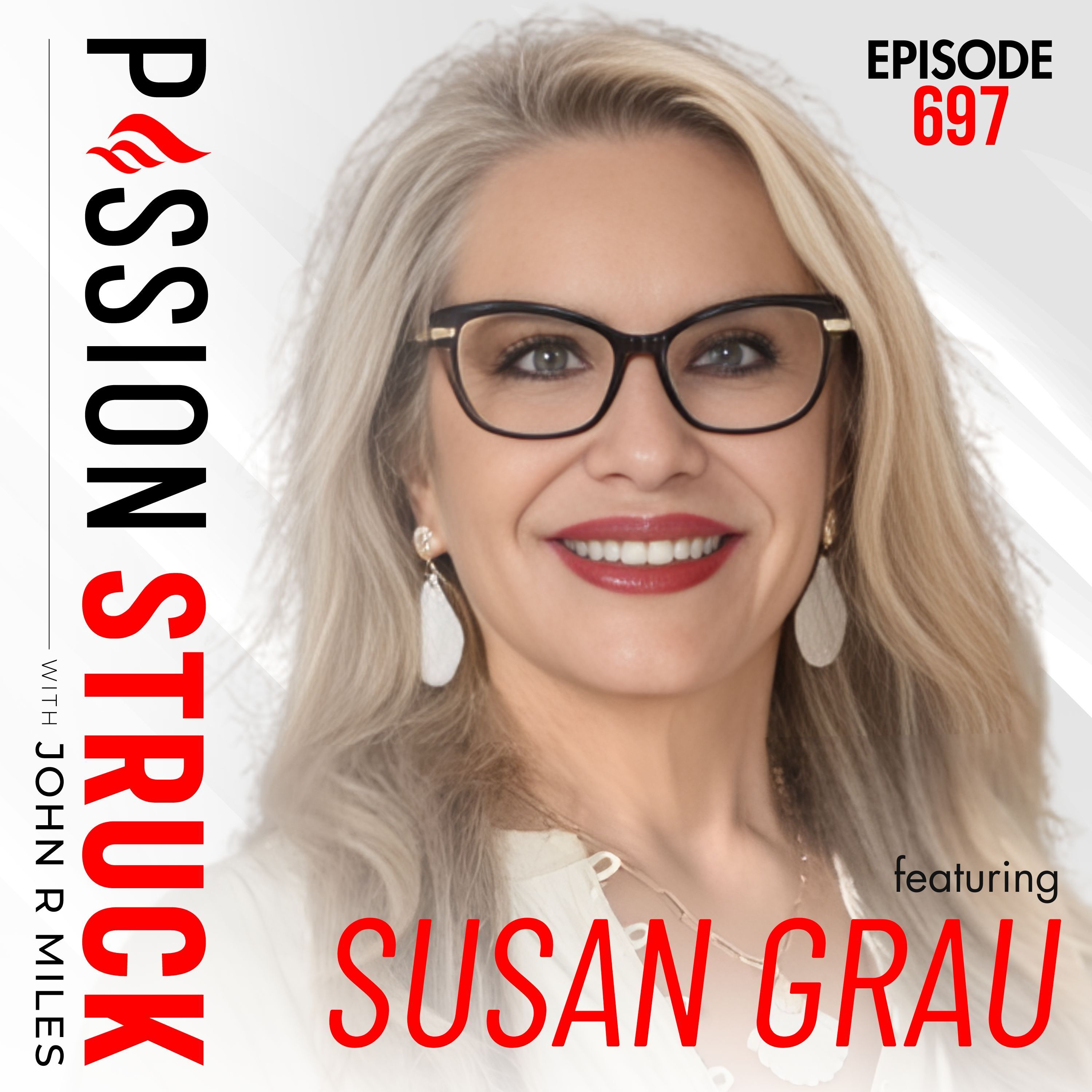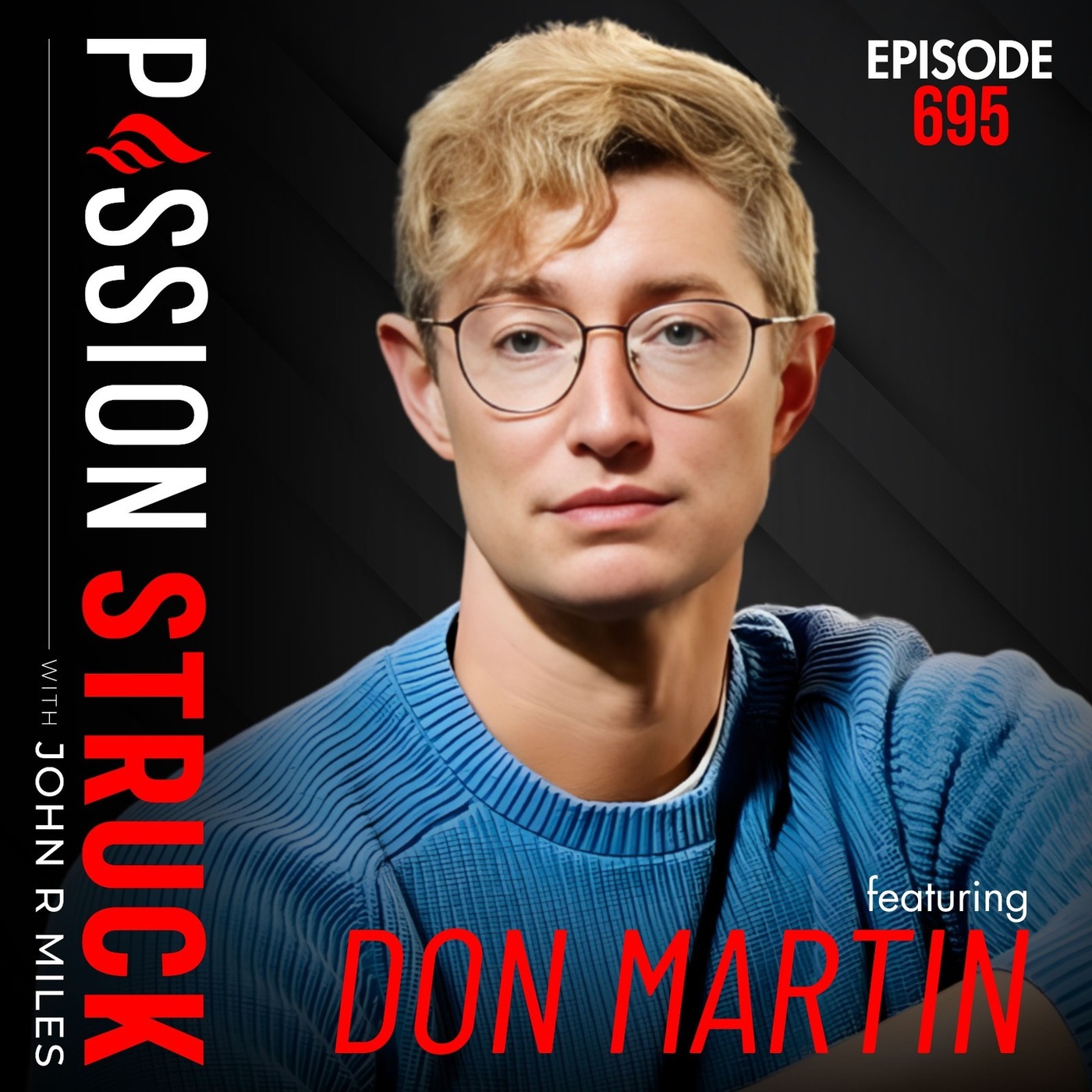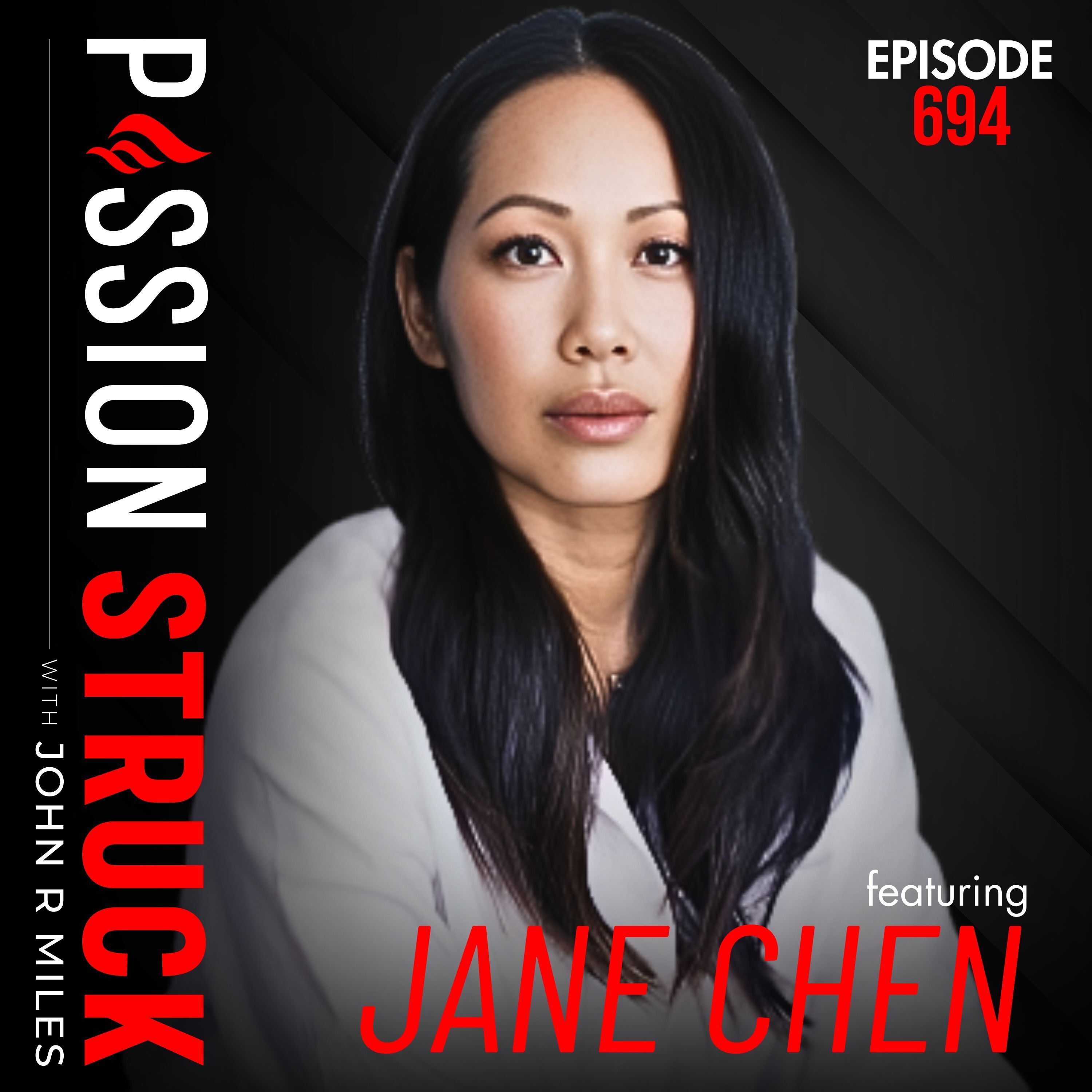Why Hope Matters: Believe You Matter and Create Big Ripples of Change | EP 558
Press play and read along
Transcript
Speaker 1 Coming up next on Passion Struck, what if hope isn't just a feeling, but a force.
Speaker 1 A force that rebuilds communities, drives revolutions, and transforms ordinary people into extraordinary catalysts for change.
Speaker 1 In episode 558, we uncover the surprising truth about hope, how it thrives, how it spreads, and how it can reshape the world.
Speaker 1 Hope isn't just about believing in a better tomorrow, it's about knowing you matter today.
Speaker 2 Curious? Stay Stay tuned.
Speaker 1 Welcome to Passion Struck.
Speaker 2 Hi, I'm your host, John R.
Speaker 2 Miles, and on the show, we decipher the secrets, tips, and guidance of the world's most inspiring people and turn their wisdom into practical advice for you and those around you.
Speaker 2 Our mission is to help you unlock the power of intentionality so that you can become the best version of yourself. If you're new to the show, I offer advice and answer listener questions on Fridays.
Speaker 1 We have long-form interviews the rest of the week with guests ranging from astronauts to authors, CEOs, creators, innovators, scientists, military leaders, visionaries, and athletes.
Speaker 1 Now, let's go out there and become passion struck. Welcome back, everyone, to Momentum Friday in episode 558 of Passion Struck.
Speaker 2 Whether you're a long-time listener or brand new to the show, I am so glad you're here.
Speaker 2 This is the place where we explore intentional living, challenge conventional thinking, and uncover what it truly means to live a a life of purpose, passion, and impact.
Speaker 1 Before we jump into today's episode, let's take a moment to recap the incredible lineup we've had on the show recently.
Speaker 2 On Tuesday, I was joined by Max Luguevert, who shared groundbreaking insights in how nutrition and lifestyle choices shape our brain health and longevity.
Speaker 2 Max's expertise is a game changer for anyone looking to take charge of their well-being and thrive, both mentally and physically.
Speaker 2 Then, on Thursday, Esther Dyson brought us an eye-opening discussion about how investing in community health and well-being is the key to creating sustaining, thriving societies.
Speaker 1 Her perspective on reframing our priorities and focusing on the long game of health is a must-listen for anyone passionate about making a lasting impact.
Speaker 1 For those of you new to the show, welcome to the Passion Struck family. With over 550 episodes, I know it can feel overwhelming to decide where to start, but don't worry, we've made it super easy.
Speaker 1 Head over to passionstruck.com slash starter packs or browse our curated Spotify playlist to explore topics like mindset, resilience, emotional health, spiritual growth, and personal development.
Speaker 2 These resources are designed to help you jumpstart your intentional journey with Passion Struck. And while you're there, be sure to sign up for my Live Intentionally newsletter at PassionStruck.com.
Speaker 2 Each week I share strategies and thought-provoking insights to help you thrive in every area of your life.
Speaker 2
Don't forget to subscribe to our YouTube channel for episode highlights and engaging content designed to inspire and empower. Now let's dive in to today's episode.
It wasn't a box.
Speaker 2 That's the first thing you need to know about Pandora's famous story. In the original Greek myth, Pandora was given a jar, a pithis, not a box.
Speaker 2
But when Eurasma mistranslated the text centuries later, the jar became a box and the imagery stuck. This detail might seem trivial, but it's not.
It tells us something important about how we think.
Speaker 1 We fixate on the wrong things, the container, the packaging, the story we think we know. But the real question, the one we've overlooked, isn't about the jar, it's about what was left behind.
Speaker 1 When Pandora opened the jar, Zeus's gifts escaped. Suffering, disease, despair, all the evils of the world spilled out, reshaping human existence forever.
Speaker 2 But one thing didn't escape. One thing stayed behind.
Speaker 1 Hope.
Speaker 2 Here's where it gets interesting.
Speaker 1 Why hope?
Speaker 2 Was it an accident? A cruel joke by the gods? Or was it intentional?
Speaker 1 A safeguard ensuring that humanity had the one thing it would need the most in the face of chaos.
Speaker 2 Fast forward a few thousand years, February 1960, four young men step into history. They walk into a Woolworths lunch counter in Greensboro, North Carolina.
Speaker 2
They sit at a whites-only counter and refuse to leave. The action is small, quiet.
They have no guarantees that their protests will succeed, but they believe their presence matters.
Speaker 2
And that belief, the belief that what they're doing has significance, sparks a fire of change. This isn't myth.
This is real life.
Speaker 1
And yet, it's no less extraordinary. This is the power of hope.
It's not just a feeling. It's a force.
Hope survives where logic says it shouldn't.
Speaker 1 It transforms ordinary actions into extraordinary movements. But why does hope thrive in some places and vanish in others?
Speaker 1 And what happens when hope connects with something even deeper, our need to matter?
Speaker 1 Let's explore the hidden link between hope and mattering, how it fuels revolutions, rebuilds communities, and transforms lives, and maybe, just maybe, how it can change yours.
Speaker 2 Thank you for choosing Passion Struck and choosing me to be your host and guide on your journey to creating an intentional life.
Speaker 1 Now, let that journey begin.
Speaker 1 Hope is one of those forces that's so fundamental to our lives, we rarely stop to question it.
Speaker 1 It's the quiet current running beneath every decision we make, every risk we take, and every challenge we endure. But, unlike fear or ambition, hope doesn't demand our attention.
Speaker 1 It works in the background, nudging us forward. And yet, it's often in the moments when hope should feel most impossible that its true power reveals itself.
Speaker 1
We've already touched on the Greensboro sit-ins, a quiet act that ignited a wave of transformation. But let's look closer.
What exactly made those four young men walk into that Woolworths?
Speaker 1 And why did their actions ripple so far, so quickly? It was February 1st, 1960.
Speaker 1 Four freshmen from North Carolina A ⁇ T, Ezelle Blair Jr., Franklin McCain, Joseph McNeil, and David Richmond, walked into Woolworths and sat at the whites-only lunch counter.
Speaker 1
They weren't loud or confrontational. They didn't shout slogans or hold signs.
They just sat and they stayed. And when they were told they couldn't be served, they didn't leave.
Speaker 1
By refusing to leave, they were making a simple yet profound statement. We belong here too.
Now, on its surface, that might not seem seem remarkable. After all, these were just four college freshmen.
Speaker 1
They weren't famous. They had no political power.
And yet, what they did that day reverberated far beyond that small lunch counter. Within days, other students joined them.
Speaker 1 Within weeks, sit-in spread across the South. And within months, Walrus and other major chains were forced to change their policies.
Speaker 1 What started with four young men in Greensboro became a tipping point for the civil rights movement, a moment when hope turned into action action and action turned into transformation.
Speaker 1
Here's what's extraordinary. Those four young men had no guarantees.
They didn't know if their protests would succeed. In fact, they had every reason to believe it wouldn't.
Speaker 1 And yet, they believed their actions mattered. They believed that by sitting at that counter, they could challenge an entire system of segregation.
Speaker 1 And that belief, quiet, fragile, yet unshakable, was contagious. It gave others permission to act, to believe that they too could make a difference.
Speaker 1 What happened in Greensboro wasn't just about lunch counters.
Speaker 1 It was about creating a culture of hope, a culture where people understood that their presence, their choices, their actions had significance. And this is the fascinating thing about hope.
Speaker 1
It doesn't thrive in isolation. Hope grows when it's tethered to mattering.
The belief that what we do, no matter how small, is part of something bigger. So let's pause here.
Speaker 1
Picture yourself in their shoes. Imagine being one of those four young men walking into Woolworths.
Would you have had the same hope?
Speaker 1 Would you have believed your actions mattered enough to risk humiliation or worse? Or would you have thought, what I do won't change anything?
Speaker 1
These are the kinds of questions hope forces us to confront, not in the abstract, but in the real, messy complexity of life. Because hope isn't about certainty.
It's about possibility.
Speaker 1 It's about taking intentional action, even when the outcome is uncertain, and trusting that what you do can ripple outward in ways you can't predict. And here's the fascinating thing.
Speaker 1
That's exactly how hope works. What begins as a flicker in one person doesn't stay contained.
It ripples outward, sparking action, connection, and ultimately transformation.
Speaker 1
But for hope to endure, it needs that critical ingredient, the belief that our actions have significance. Without that, hope withers.
But with it, hope becomes unstoppable.
Speaker 1
Most people feel feel that the things they do don't really matter. I mean, in a world of 8 billion people, it's easy to feel insignificant.
Most of us do.
Speaker 1 We tell ourselves that our actions, the choices we make, the things we do, don't really matter. But what if that assumption is wrong? What if the opposite is true?
Speaker 1 What if the belief that your actions matter isn't just a comforting idea, but a force, a force that shapes the world around us?
Speaker 1 Let me take you back to 1944, Auschwitz, a place where hope should have been impossible. And yet, Viktor Frankl, a Jewish psychiatrist in prison there, noticed something extraordinary.
Speaker 1 He observed that survival wasn't about physical strength or even luck. It was about something far less tangible, hope.
Speaker 1 Frankl realized that those who could imagine a future beyond the barbed wire, a reunion with loved ones, the chance to rebuild their lives, had an anchor that kept them going.
Speaker 1 Hope in this context wasn't naive or passive. It was defiant.
Speaker 1 It allowed people to believe that their suffering had meaning, that they still mattered, even when the world seemed indifferent to their existence.
Speaker 1
This insight became the foundation of Frankl's life work. Hope isn't just a feeling.
It's a way of thinking. It's the belief that our lives hold purpose, even in the darkest of times.
Speaker 1 Hope, he discovered, anchors us to the idea that we matter, not in spite of the challenges we face, but because of them. But here's what's fascinating.
Speaker 1
Hope doesn't just operate on an individual level. It flourishes in connection.
It thrives when it's shared. Take communities.
Speaker 1 When disaster strikes, it's often not the large institutions or government systems that ignite resilience. It's the small, quiet acts of connection that transform despair into recovery.
Speaker 1
I saw this firsthand in the aftermath of Hurricane Helene and Hurricane Milton. The storms left destruction in their wake.
Trees uprooted, power lines down, neighborhoods eerily still.
Speaker 1
My family had barely begun assessing the damage when the calls started coming in. Not from emergency services, but from friends.
What can we do to help, they asked, and they meant it.
Speaker 1
One friend arrived with supplies we hadn't even thought to ask for. Another showed up, unprompted, to clear branches from our yard.
These weren't just gestures of kindness.
Speaker 1
They were acts of ownership. Our recovery wasn't just ours anymore.
It belonged to them too. These weren't grand acts, but they weren't small either.
This wasn't just kindness. It was hope in action.
Speaker 1
Each one reminded us of something profound. We mattered, not just to ourselves, but to others.
And that knowledge that someone saw us, that someone cared, sparked something.
Speaker 1 Seeing others step in inspired us to do the same for our neighbors. Hope rippled through our community, not just as an abstract concept, but as tangible, meaningful acts of connection.
Speaker 1 The ripple effect of hope is what makes it so powerful. It starts as an internal force, our belief in the possibility of change, but it becomes transformative when shared.
Speaker 1
That's where hope ties directly to mattering. It's not just about survival or success, it's about significance.
Hope reminds us that our efforts, no matter how small, have meaning.
Speaker 1 However, a vital question stands out. If hope is so powerful, why does it feel so fragile? Why does it thrive in some moments and vanish in others? That's the question we need to answer next.
Speaker 1
Hope, in its essence, is a paradox. It's fragile, yet it endures.
It asks us to believe in things we can't see and to move forward even when the path isn't clear.
Speaker 1 So, hope feels fragile, even though it's so essential, because it doesn't promise certainty. It doesn't guarantee outcomes.
Speaker 1 What it does is sustain us in the uncertainty, reminding us that that our lives are worth the fight and that our contributions matter. But hope isn't passive.
Speaker 1
It's not just a flicker of light in a dark room. Hope is active.
It pushes us to act, to create, to fight for something better. And here's the remarkable part.
Speaker 1 The moment we act on hope, it transforms from a belief into a driving force.
Speaker 1 To understand this, let's revisit an experiment conducted in the 1950s by Kurt Richter, a psychologist at Johns Hopkins University.
Speaker 1
Richter wanted to study resilience, what kept living beings going in the face of impossible odds. His subjects were rats, placed in jars of water, forced to swim.
Initially, the results were grim.
Speaker 1 Most rats swam for just a few minutes before giving up and sinking. But then, Richter tried something different.
Speaker 1
Just as the rats were about to give up, he pulled them out, dried them off, and gave them a moment to recover. Then he placed them back in the water.
The outcome was startling.
Speaker 1
These same rats, who had only managed a few minutes before, now swam for hours. Why? Because they had learned something new.
Their struggle wasn't futile. They had experienced rescue.
Speaker 1
They had a reason to keep going. This experiment is unsettling, but it reveals something profound about hope.
Hope isn't born from certainty or guarantees.
Speaker 1
It emerges when we believe there's a chance, however slim, that our efforts will make a difference. It's not the guarantee of rescue that drives us.
It's the possibility of it.
Speaker 1
Now, let's think about Viktor Frankl. In Auschwitz, Frankl didn't just cling to hope as a comforting idea.
He acted on it. He envisioned a future where suffering had purpose.
Speaker 1 He saw himself teaching others, sharing the lessons of his experience, and contributing something meaningful to the world. That vision fueled his actions, even in the face of unimaginable despair.
Speaker 1
Hope wasn't just a lifeline. It was his engine for survival and transformation.
This idea that hope bridges the gap between belief and action plays out in countless ways in everyday life.
Speaker 1 Think of a single parent working multiple jobs, driven not just by necessity, but by the hope of creating a better life for their children.
Speaker 1 Or consider a community rebuilding after a disaster, clearing debris, delivering supplies. These acts might seem small in isolation, but together they represent something far bigger.
Speaker 1
The belief that recovery is possible. Here's where it gets even more interesting.
Hope isn't just transformative on a personal level. It thrives when it's shared.
Consider Gandhi.
Speaker 1 He didn't just hope for India's independence. He turned that hope into a movement.
Speaker 1 His leadership wasn't transformative because he promised success, but because he convinced millions that their individual actions mattered.
Speaker 1
Gandhi showed people that their efforts were part of something far greater than themselves. This is the secret of hope.
It's not static and it's not solitary.
Speaker 1
It becomes powerful when paired with intentional action. It moves us from, I wish things were different to, I'm going to make things different.
And when hope is shared, it creates ripples.
Speaker 1
Ripples that foster connection, belonging, and purpose. But here's the question.
Why does hope flourish when it's shared?
Speaker 1 What is it about connection that transforms hope from a personal lifeline into a collective force capable of reshaping lives, communities, and even history?
Speaker 1 If hope is a spark, then community is the oxygen that feeds the flame. Alone, hope can sustain us for a time, but its true power lies in its ability to multiply when when shared.
Speaker 1 It's not just an individual experience, it's a social phenomenon, and that's where the science gets interesting.
Speaker 1 In the 1990s, a psychologist named Shelley Taylor at UCLA started researching what happens to people under stress.
Speaker 1 Traditionally, psychologists had focused on the fight-or-flight response, the idea that in moments of crisis, humans either confront the challenge head-on or flee to safety.
Speaker 1
But Taylor noticed something curious. In many situations, people didn't fight or flee.
They gathered. They turned to others for support, connection, and cooperation.
Speaker 1 Taylor called this the tend and befriend response. It's a behavior deeply rooted in our biology, driven by the release of oxytocin, a hormone that encourages bonding and trust.
Speaker 1
In moments of crisis, we don't just survive by clinging to individual hope. We thrive by sharing it with others.
This is why, After disasters, we often see spontaneous acts of generosity.
Speaker 1
Neighbors helping neighbors, strangers forming rescue chains. It's not just altruism, it's biology.
Sharing hope strengthens our own. Now, consider how this plays out on a larger scale.
Speaker 1 When Gandhi launched his campaign for India's independence, he didn't just give people hope for a free India. He made them part of the process.
Speaker 1 His non-violent movement wasn't about waiting for change. It was about collective action.
Speaker 1 Every march, every boycott, every simple refusal to cooperate with the British government became a shared declaration of hope. Gandhi wasn't just a symbol of independence.
Speaker 1 He was a conduit for people to believe in their own power. This same principle explains why hope flourishes in movements, from the civil rights struggles of the 1960s to climate action today.
Speaker 1 Individual hope might inspire action, but collective hope creates momentum. It's the belief that you're not alone, that your efforts matter because they're part of something larger.
Speaker 1 Here's the paradox. The very moments that seem designed to isolate us, disasters, oppression, crises, are often the ones that draw us together more powerfully.
Speaker 1 When hope is shared, it doesn't just help us endure, it transforms us. It turns survival into significance.
Speaker 1 There's a hidden ingredient in shared hope that often goes unnoticed, the sense that we matter.
Speaker 1 Hope isn't just about believing in a better future, it's about believing that we have a role in creating it. Without this connection, hope can falter.
Speaker 1 But when people feel seen, when their actions are recognized as significant, Hope doesn't just persist, it flourishes. Consider this.
Speaker 1 During the Montgomery bus boycott, the success of the movement didn't rest solely on its leaders or its strategy. It rested on ordinary people.
Speaker 1 Domestic workers, students, ministers, who were reminded, often for the first time, that their presence mattered.
Speaker 1
Every individual who walked miles to avoid the buses, every volunteer who organized carpools, became a critical part of the movement's success. They weren't just participants.
They were indispensable.
Speaker 1 Their hope was fueled by the knowledge that their actions, however small, had meaning. Psychologists have a term for this, mattering.
Speaker 1 It's the feeling that we're important to others, that what we do is noticed and valued. And it turns out, mattering is deeply connected to hope.
Speaker 1 Research shows that when people feel insignificant, when they believe their contributions don't matter, they're more likely to experience hopelessness.
Speaker 1
But when they feel seen and valued, hope becomes possible again. This isn't just about social movements or historic moments.
Think about the small, everyday ways we experience this connection.
Speaker 1 A teacher tells a struggling student, I believe in you. A coach reminds a player that their effort on the field inspires the entire team.
Speaker 1 These moments might seem fleeting, but their impact is profound. Being seen doesn't just validate our existence, it gives us permission to hope.
Speaker 1 One of the clearest examples of this connection between hope and mattering comes from Martin Luther King Jr.'s leadership during the Civil Rights Movement.
Speaker 1
King didn't just deliver speeches about a dream. He gave people a sense sense of agency within that dream.
He made them believe that their voices, their presence, their courage could create change.
Speaker 1
For the marchers on Selma's Edmund Pettus Bridge, hope wasn't abstract. It was tied to the belief that they mattered.
Their actions weren't just symbolic. They were essential.
Speaker 1 And this brings me to one of the most important lessons from today's episode. Hope alone sustains us for a time, but its true power lies in its ability to multiply when shared.
Speaker 1 Now, consider how this plays out in smaller, less visible ways. After Hurricane Helene, the acts of friends and neighbors weren't just about clearing debris or sharing supplies.
Speaker 1 Each knock on the door, each phone call asking, how can I help, was a reminder, you are not alone. In those moments, hope wasn't just shared.
Speaker 1
It was reinforced by the knowledge that individual lives and efforts mattered to the collective recovery. This brings me to a critical point.
Hope struggles to take root in isolation.
Speaker 1 When people feel unseen or insignificant, they're less likely to believe in a better future.
Speaker 1 But when they are reminded through action, acknowledgement, and connection that they matter, hope finds fertile ground. It becomes not just a belief, but a force for transformation.
Speaker 1
Here's where it gets even more powerful. When individuals feel they matter, they're more likely to extend that feeling to others.
Hope ripples outward, creating a feedback loop.
Speaker 1 A single parent, encouraged by a supportive community, not only finds strength for their own struggles, but inspires their children to dream bigger a grassroots organizer motivated by recognition inspires others to step forward shared hope becomes contagious powered by the simple act of being seen this is why hope isn't just about envisioning a brighter future it's about building one together and it starts with acknowledging that every action every voice every person has significance when hope and mattering intersect, they create the foundation for resilience, innovation, and lasting change.
Speaker 1 If hope flourishes when people feel they matter, the next logical question is this. How do we intentionally cultivate that sense of mattering in others?
Speaker 1 How do we create an environment where hope isn't just a fleeting feeling, but a sustained force for change? Let's start with something deceptively simple. Acknowledgement.
Speaker 1 In the late 1990s, researchers at the University of Michigan studied what motivates employees to perform better in the workplace.
Speaker 1 They expected to find that higher salaries or more autonomy played the biggest biggest roles, but the data revealed something surprising. The single most powerful motivator was recognition.
Speaker 1 When managers acknowledge someone's contributions, publicly or privately, it didn't just improve performance, it strengthened the employee's belief that their work mattered.
Speaker 1
This insight extends far beyond the workplace. In any context, acknowledgement signals to someone that they're seen, that their efforts aren't invisible.
And here's the fascinating part.
Speaker 1
Acknowledgement doesn't have to be grand or elaborate to be effective. It can be as simple as saying, thank you.
That wouldn't have been possible without you. These small moments create ripples.
Speaker 1 They give people the energy to keep going, and crucially, the belief that their actions make a difference.
Speaker 1 Cognitive neuroscientist Emile Bruno saw this play out in some of the world's most polarized conflicts.
Speaker 1 His groundbreaking work explored what happens when people who are deeply divided, politically, culturally, or ideologically, feel acknowledged.
Speaker 1 In one of his most profound studies, Bruno worked with Israelis and Palestinians, asking them to participate in what he called perspective giving sessions.
Speaker 1 One group was asked to share their experiences, while the others simply listened without interruption. The results were remarkable.
Speaker 1 When participants felt truly heard, even by someone from the opposing side, their hostility softened.
Speaker 1 Acknowledgement didn't resolve decades of tension overnight, but it created an opening, a sense that their experiences and identities mattered, and from that sense of mattering, hope began to emerge.
Speaker 1
The hope that dialogue was possible, that solutions could be built, that the future might look different from the past. Bruno's work teaches us something essential.
Acknowledgement isn't passive.
Speaker 1
It's an active, deliberate practice. It requires presence, effort, and vulnerability.
But when we practice it, it has a cascading effect.
Speaker 1 When people feel seen, they're more likely to see others in turn. They extend recognition outward, creating a feedback loop of connection and belonging.
Speaker 1 This is how acknowledgement transforms from an individual moment into a collective force. Another strategy for cultivating hope and mattering is inclusion.
Speaker 1 In 2016, a grassroots organization in Baltimore launched a community-led initiative to clean up neighborhoods affected by years of neglect.
Speaker 1 Instead of relying on external contractors, they invited residents to lead the charge. They provided tools and training, but the work and the decision-making belonged to the people who lived there.
Speaker 1
The results were transformative. It wasn't just the neighborhoods that changed.
The residents themselves began to see their communities differently.
Speaker 1 By being included in the process, they gained not just cleaner streets, but a renewed belief in their ability to shape their environment. This approach highlights a critical truth.
Speaker 1 When we involve people in solutions, we're not just addressing problems, we're building hope. Inclusion reminds people that their voices and actions are integral to the outcome.
Speaker 1 It shifts them from being passive recipients to active participants, reinforcing their sense of agency and connection. Leadership too plays a vital role in cultivating hope.
Speaker 1
And here's where the most effective leaders stand apart. They don't just set goals or articulate visions.
They make people believe they are essential to achieving them.
Speaker 1 In 2013, a group of researchers analyzed speeches by some of history's most iconic leaders, from Winston Churchill to Barack Obama. They found a common thread.
Speaker 1
Great leaders, it turns out, don't just talk about what needs to happen. They highlight who will make it happen.
They weave their audience into the narrative, giving them ownership of the vision.
Speaker 1 It's not, here's what I will do, but here's what we will do, and here's why your role matters.
Speaker 1 These strategies, acknowledgement, inclusion, and leadership, that highlight individual contributions aren't revolutionary, but that's precisely the point.
Speaker 1
Transforming hope into a sustainable force doesn't require sweeping changes or dramatic gestures. It's built in the small, consistent acts of seeing, hearing, and valuing others.
The result?
Speaker 1
A cycle of hope and mattering that feeds itself. When people feel they matter, they're more likely to take action.
And when they act, they give others a reason to hope.
Speaker 1 This feedback loop, simple as it may seem, is the foundation of resilience, innovation, and progress. So what does this mean for us?
Speaker 1 It means that cultivating hope isn't about waiting for the right moment or the perfect conditions.
Speaker 1 It's about starting small, recognizing effort, inviting others in, and reminding people of their significance. It's about taking the spark of hope and fanning it into something larger.
Speaker 1
Hope is often misunderstood as a quiet internal force, but history tells us otherwise. It's an amplifier.
When tethered to the belief that we matter, hope doesn't just move us, it moves others.
Speaker 1 It's why four students at a lunch counter could spark a national movement. It's why prisoners could survive the worst of treatments in a concentration camp.
Speaker 1
And it's why everyday people endure hardships, believing for a better future. Hope, when shared, becomes more than an emotion.
It becomes a catalyst for change. So where does this leave us?
Speaker 1 It's easy to dismiss hope as wishful thinking, but what if we saw it for what it really is? A call to action?
Speaker 1 Hope tells us that tomorrow can be different, but only if we recognize our own role in shaping it. And when we act on that belief, hope becomes something extraordinary.
Speaker 1 A reminder that we matter and that the world is better for it. And that's a wrap for today's episode.
Speaker 1 I hope this exploration of hope, mattering, and their profound ripple effects has inspired you to reflect on your own ability to create change in your life and in the lives of others.
Speaker 1 If today's discussion resonated with you, I'd be so grateful if you could take a moment to leave a five-star rating in review.
Speaker 1 Your support helps others discover the show and join us on this journey of intentional living and transformation.
Speaker 1 If you know someone who might benefit from today's message, whether they're facing challenges or simply need a reminder of their significance, please share this episode with them.
Speaker 1 Together, we can amplify these ideas and spark a wave of positive impact.
Speaker 1 As we continue into 2025, I'm excited to bring you more thought-provoking content that inspires action, fosters resilience, and equips you to live a life of intention and meaning.
Speaker 1 If you'd like to explore these principles with your team or organization, I'd love to work with you through keynote speeches, workshops, or events.
Speaker 1 Visit johnrmiles.com slash speaking to learn how we can partner to ignite purpose and growth this year.
Speaker 1 For links, resources, and takeaways from today's episode, head to the show notes at passionstruck.com. Don't forget to check out the video version of this episode on our YouTube channel.
Speaker 1
And while you're there, hit the subscribe so you never miss an episode or highlight. Supporting the show is easy.
Visit passionstruck.com slash deals for exclusive offers from our sponsors.
Speaker 1
It's a great way to support the brands that make the show possible. Before we go, here's a sneak peek at next week's episode.
I'll be joined by my friend Dr.
Speaker 1 Rick Hansen, a psychologist and best-selling author, for an enlightening conversation on the science of happiness and how to hardwire resilience into your brain. You won't want to miss it.
Speaker 3 I think that autonomy is crucial. Autonomy is the foundation of intimacy.
Speaker 3 We can't be connected with others if we don't feel that we're coming coming from a kind of an internalized, secure base inside ourselves. And without mindfulness, we lack autonomy.
Speaker 3 We're pushed around by this or that, including the internalized impact of life experiences going all the way back to early childhood that we don't even remember.
Speaker 3 Those forces are like strings pulling us as a puppet. With mindfulness, snip, snip, snip, we start.
Speaker 3 cutting those strings and we become more and more our own person at home in ourselves in charge of ourselves.
Speaker 2 Thank you, as always, for spending your time with me today.
Speaker 1 Your commitment to growing, learning, and living intentionally inspires me every single day.
Speaker 2
I hope this episode has reminded you that hope isn't just a feeling, it's a force. And it starts with the belief that you matter.
Because when people believe they matter, they act.
Speaker 2 And when people act, they create hope not just for themselves, but for everyone around them. Remember, the fee for this show is simple.
Speaker 2
If you found value here, share it with someone who might benefit. Until next time, keep leaning into curiosity, purpose, and connection.
And as always, live life passion strong.
